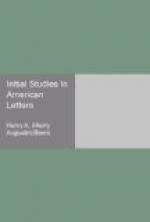From time to time Emerson collected and published his lectures under various titles. A first series of Essays came out in 1841, and a second in 1844; the Conduct of Life in 1860, Society and Solitude in 1870, Letters and Social Aims in 1876, and the Fortune of the Republic in 1878. In 1847 he issued a volume of Poems, and 1865 Mayday and Other Poems. These writings, as a whole, were variations on a single theme, expansions and illustrations of the philosophy set forth in Nature, and his early addresses. They were strikingly original, rich in thought, filled with wisdom, with lofty morality and spiritual religion. Emerson, said Lowell, first “cut the cable that bound us to English thought and gave us a chance at the dangers and glories of blue water.” Nevertheless, as it used to be the fashion to find an English analogue for every American writer, so that Cooper was called the American Scott, and Mrs. Sigourney was described as the Hemans of America, a well-worn critical tradition has coupled Emerson with Carlyle. That his mind received a nudge from Carlyle’s early essays and from Sartor Resartus is beyond a doubt. They were life-long friends and correspondents, and Emerson’s Representative Men is, in some sort, a counterpart of Carlyle’s Hero Worship. But in temper and style the two writers were widely different. Carlyle’s pessimism and dissatisfaction with the general drift of things gained upon him more and more, while Emerson was a consistent optimist to the end. The last of his writings published during his life-time, the Fortune of the Republic, contrasts strangely in its hopefulness with the desperation of Carlyle’s later utterances. Even in presence of the doubt as to man’s personal immortality he takes refuge in a high and stoical faith. “I think all sound minds rest on a certain preliminary conviction, namely, that if it be best that conscious personal life shall continue it will continue, and if not best, then it will not; and we, if we saw the whole, should of course see that it was better so.” It is this conviction that gives to Emerson’s writings their serenity and their tonic quality at the same time that it narrows the range of his dealings with life. As the idealist declines to cross-examine those facts which he regards as merely phenomenal, and looks upon this outward face of things as upon a mask not worthy to dismay the fixed soul, so the optimist turns away his eyes from the evil which he disposes of as merely negative, as the shadow of the good. Hawthorne’s interest in the problem of sin finds little place in Emerson’s philosophy. Passion comes not nigh him, and Faust disturbs him with its disagreeableness. Pessimism is to him “the only skepticism.”
The greatest literature is that which is most broadly human, or, in other words, that which will square best with all philosophies. But Emerson’s genius was interpretative rather than constructive. The poet dwells in the cheerful world of phenomena. He is most the poet who realizes most intensely the good and the bad of human life. But Idealism makes experience shadowy and subordinates action to contemplation. To it the cities of men, with their “frivolous populations,”




